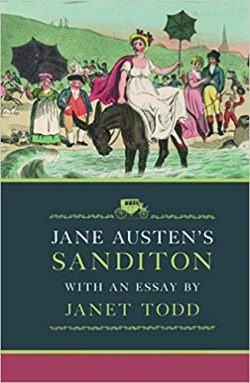Welcome to Sanditon, an 1819 Regency seaside community in Sussex England—the fictional site of the new ITV/PBS television adaptation/continuation of Jane Austen’s final unfinished novel. For those who are watching the eight-part series currently airing in the US on PBS, The World of Sanditon, by Sara Sheridan will be catnip to heighten your addiction. A... Continue Reading →
In Conversation with Janet Todd, Editor, and Essayist of Jane Austen’s Sanditon
I recently read and reviewed the delightful Jane Austen’s Sanditon, an excellent new edition in the crowded Austen book market whose timely release, along with the new ITV/PBS eight-part television adaptation/continuation inspired by the unfinished novel, has brought Jane Austen’s last work into the limelight. I have long followed the career of its editor, Janet... Continue Reading →
Jane Austen’s Sanditon: With An Essay by Janet Todd — A Review
From the desk of Laurel Ann Nattress: Sanditon, Jane Austen’s last unfinished novel is in the news. A new TV adaptation and continuation of the same name premiered in the UK on ITV on August 25, 2019. The new eight-part series was written by Andrew Davies (Pride and Prejudice 1995) and will be shown on... Continue Reading →
5 Sanditon-inspired Novels that Complete Jane Austen’s Last Unfinished Work
Jane Austen’s last unfinished novel Sanditon ended after 22,000 words and midway into what may have been chapter twelve. Her draft manuscript was a bright beginning introducing us to the seaside town in development as a health resort and a list of over 20 characters. For anyone who has turned to the last page and... Continue Reading →
Sanditon, by Jane Austen (Hesperus Press): A Review
From the desk of Laurel Ann Nattress: On the 27th of January, 1817 Jane Austen began work on a novel that is now known as Sanditon. It was never completed. Her declining health robbed her of what she dearly loved most, writing, and on the 18th of March 1817 after penning 22,000 words she wrote... Continue Reading →
By the Seaside with Sanditon: Sea-Bathing, a match to every disorder in the 19th-century
Why would anyone want to go into freezing cold sea water? What medical benefits were they hoping to achieve? In Jane Austen’s novel Sanditon an entire seaside community is in development to attract visitors to a new watering place for the therapeutic or curative benefit of sea-air and sea-bathing. This involved the process of immersing yourself... Continue Reading →
Sanditon Group Read Chapters 9-12: Summary, Musings & Discussion: Day Six Giveaway
It was impossible for Charlotte not to suspect a good deal of fancy in such an extraordinary state of health. Disorders and recoveries so very much out of the common way seemed more like the amusement of eager minds in want of employment than of actual afflictions and relief. The Narrator, Ch 9 Quick Synopsis... Continue Reading →
By the Seaside with Sanditon: Guest Blog with Mandy N. on Regency-era Seaside Fashions
Please welcome Mandy N. today as a guest blogger during 'By the Seaside with Sanditon'. Mandy is an avid collector of vintage fashion plates and has graciously offered to share some of her lovely images and chat about Regency-era fashion that I am quite certain Mr. Parker would think quite elegant enough for Sanditon. During the Regency-era, seaside resorts... Continue Reading →
By the Seaside with Sanditon: Worthing, the inspiration for Sanditon?
Eastbourne vs. Worthing? As we continue to explore Jane Austen’s last unfinished novel Sanditon it is interesting to ponder what Jane Austen used to model her emerging seaside resort of Mr. Parker’s creation. Julie at Austenonly presents a strong argument for the resort for Worthing in Sussex, also an emerging seaside resort in the early... Continue Reading →
Sanditon Group Read Chapters 5-8: Summary, Musings & Discussion: Day Four Giveaway
"We have consulted physician after physician in vain, till we are quite convinced that they can do nothing for us and that we must trust to our own knowledge of our own wretched constitutions for any relief." Diana Parker Chapter 5 Quick Synopsis A letter from Diana Parker updates her brother on their ongoing health... Continue Reading →
By the Seaside with Sanditon: Sir Edward Denham’s Sentimental Stirrings about the Sea & Seduction
He began, in a tone of great taste and feeling, to talk of the sea and the sea shore; and ran with energy through all the usual phrases employed in praise of their sublimity and descriptive of the undescribable emotions they excite in the mind of sensibility. The terrific grandeur of the ocean in a storm,... Continue Reading →
On the Trail of Jane Austen’s Sanditon: The History of the Manuscript
From the desk of Laurel Ann Nattress: "She continued to work at it as long as she could work at all." James Edward Austen-Leigh (1871) On the 27th January, 1817 Jane Austen began work on a novel that is now known as Sanditon. It was never completed. She was gravely ill, and after a brief... Continue Reading →











